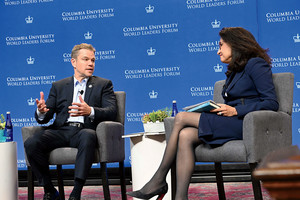On a recent Tuesday evening, George E. Rupp, president of Columbia from 1993 to 2002, returned to the University for a public talk with his old Harvard classmate and fellow New Jerseyan Mark C. Taylor, codirector of the Institute for Religion, Culture, and Public Life. After a casual back-and-forth on growing up in the Garden State and discovering Hegel, the subject turned to a problem Rupp now faces daily as president of the International Rescue Committee (IRC): refugee camps.
“I remember the first camp I visited,” Rupp told the audience of some 60 students and faculty in the International Affairs Building. “It was for Burundian refugees in Tanzania. I went away completely depressed. People had been there for 20 years. Lots of kids were born there, grew up there. They actually got better education and health care than they would have gotten if they weren’t in the camp, but, as a result, they were incapable of going back where their parents came from, incapable of supporting themselves.”
Today there are 40 million displaced people worldwide. The IRC, a relief and refugee-assistance NGO founded in 1933 to save refugees from Nazi Germany and transfer them to the United States, helps resettle the roughly 10,000 refugees of violent political conflicts who are admitted by the U.S. yearly. IRC caseworkers meet refugees at the airport, having already found them housing, and help them learn English, find employment, and get their children into school.
Yet the vast majority of refugees remain without hope of asylum or of returning to their homes. For this reason, the bulk of IRC’s work is now with displaced populations outside of the U.S. Its largest programs are in the Democratic Republic of Congo, Afghanistan, and now Haiti, where the earthquake has displaced an estimated 700,000 people.
Rupp, who left Columbia in June 2002 to lead the IRC, was at the organization’s headquarters in New York when the earthquake struck earlier this year. Immediately, he gathered his staff and assembled an emergency-response team to be deployed to Port-au-Prince: doctors and public-health professionals, water and sanitation engineers, social workers to help children find their families. Another task was to set up community watches to protect women from the kind of sexual violence that often erupts in temporary encampments like those already appearing in Haiti.
Tent cities have cropped up near the Port-au-Prince airport and in large parks, where aid organizations then come to distribute health services, food, and supplies, Rupp said. Conditions are squalid. In the capital’s main park, Champ de Mars, thousands of families have made temporary shelters out of sheets and sticks, and people go to the edge of the park to relieve themselves. One of the IRC’s main projects is constructing latrines, in order to keep water from getting contaminated and cholera from spreading.
“In the short term, these encampments may be the least bad way to go, but they’re not a good way,” said Rupp. “We know from experience that once a so-called temporary settlement is set up, it becomes extremely difficult to dismantle it.”
While the IRC has helped resettle Haitian immigrants in the U.S. for decades, it did not operate any programs in the island country prior to the earthquake. Now, it finds itself in the position of operating in encampments that, as Rupp observed, can create an intractable cycle of dependence.
So how long does Rupp foresee the IRC continuing these services in Haiti?
“At least the next 10 years,” he said after the talk, adding that the IRC will maintain its focus on providing community-reconstruction projects, and employing former refugees to help build infrastructure and provide medical services, as it’s done for the Rwandan refugees in Congo.
He added, however, that the organization has decided not to manage any of the camps. When asked who will, Rupp paused and said, “It’s unsettled.”


